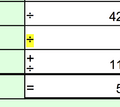Division (mathematics) facts for kids
In mathematics, division is an operation that is the opposite of multiplication. It helps us split a number into equal groups. For example, if you have 6 cookies and want to share them equally among 3 friends, each friend gets 2 cookies. This is division!
We use different symbols for division:
- A slash:

- A fraction line:

- The division sign (obelus):

All these mean "6 divided by 3," and the answer is 2.
When you divide, the first number is called the dividend (the number being split). The second number is the divisor (how many groups you're splitting it into). The answer you get is called the quotient.
Sometimes, when you divide, there's a leftover amount. This leftover is called the remainder. For example, if you divide 14 by 4:
- The dividend is 14.
- The divisor is 4.
- The quotient is 3 (because 4 goes into 14 three times).
- The remainder is 2 (because 3 times 4 is 12, and 14 minus 12 is 2).
So, 14 divided by 4 is 3 with a remainder of 2. This can also be written as 3 and a half (3.5).
Division can work with very large numbers too. For example, 200 divided by 5 equals 40. Or, 7 billion (7,000,000,000) divided by 1,000 equals 7 million (7,000,000).
Contents
Division and Multiplication: How They Connect
Division and multiplication are closely related. They are inverse operations, meaning they undo each other.
Understanding the Relationship
If you multiply two numbers, say c and b, and get a result a:
Then, if you divide a by b (as long as b is not zero), you will get c:
Let's look at an example:
This is true because:
In this example:
- a (which is 6) is the dividend.
- b (which is 3) is the divisor.
- c (which is 2) is the quotient.
Why You Can't Divide by Zero
It's important to know that you can never divide by zero. For example,  is not allowed in mathematics. Imagine trying to split something into zero groups – it just doesn't make sense!
is not allowed in mathematics. Imagine trying to split something into zero groups – it just doesn't make sense!
Different Ways to Write Division
There are several common ways to write down a division problem.
Using a Fraction Line
The most common way to show division is by putting the dividend over the divisor with a horizontal line between them. This line is called a vinculum.
You can read this as "a divided by b" or "a over b." This form is also used for fractions, where both numbers are integers. In fractions, the top number is the numerator, and the bottom number is the denominator.
Using a Slash
Another way to write division, especially in computer programming languages, is to use a slash:
This is easy to type on a keyboard. Sometimes, you might see it written with the dividend slightly raised and the divisor slightly lowered, like this: a⁄b.
Using the Obelus (Division Sign)
The obelus ( ) is another symbol for division:
) is another symbol for division:
This symbol is often used in elementary math lessons and is commonly found on calculator keys.
Using a Colon
In some countries, a colon (:) is used to mean "divided by," like a : b. However, in English-speaking countries, the colon is usually used to show a ratio, like "a is to b."
Related Math Topics
- Divisor: This word can also mean a number that divides another number exactly, with no remainder.
- Division by two: A special case of division.
- Long division: A method for dividing larger numbers.
- Remainder: The amount left over after division.
Images for kids
-
Plus and minuses. An obelus used as a variant of the minus sign in an excerpt from an official Norwegian trading statement form called «Næringsoppgave 1» for the taxation year 2010.
See also
 In Spanish: División (matemática) para niños
In Spanish: División (matemática) para niños










